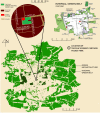Laccase activity of the ascomycete fungus Nectriella pironii and innovative strategies for its production on leaf litter of an urban park
- PMID: 32298310
- PMCID: PMC7162450
- DOI: 10.1371/journal.pone.0231453
Laccase activity of the ascomycete fungus Nectriella pironii and innovative strategies for its production on leaf litter of an urban park
Erratum in
-
Correction: Laccase activity of the ascomycete fungus Nectriella pironii and innovative strategies for its production on leaf litter of an urban park.PLoS One. 2020 May 14;15(5):e0233553. doi: 10.1371/journal.pone.0233553. eCollection 2020. PLoS One. 2020. PMID: 32407366 Free PMC article.
Abstract
A laccase-producing ascomycete fungus was isolated from soil collected around the premises of a textile dye factory and identified as Nectriella pironii. Efficient laccase production was achieved via the synergistic action of 1 mM copper sulfate and ferulic acid. Extracts of rapeseed oil cake, grass hay, and leaf litter collected in a pocket urban park were used for enzyme production. The highest laccase activity (3,330 U/L) was observed in the culture grown on the leaf litter extract. This is the first report on biosynthesis of laccase by N. pironii. This is also the first study on utilization of naturally fallen park leaves as a substrate for fungal laccase production. The extracellular enzyme possessing laccase activity was purified to homogeneity by ion-exchange and gel filtration chromatographic techniques. The amino acid sequence of the protein revealed highest similarity to the laccase enzyme produced by Stachybotrys chartarum-and considerable homology to those produced by other fungal species. The purified laccase possessed a molecular mass of 50 kDa. The enzyme had an optimum pH of 2.0 or 6.0 and retained more than 50% of residual activity after 3 hours of incubation at pH 3.0-10.6 or 4.0-9.0 when 2,2'-azino-bis(3-ethylbenzothiazoline-6-sulphonic acid or 2,6-dimethoxyphenol, respectively, were used. Dithiothreitol, β-mercaptoethanol, and sodium azide at 1 mM concentration strongly inhibited the laccase activity, while in the presence of 50 mM urea, the enzyme was found to retain 25% of its activity. The laccase was able to decolorize more than 80% of Indigo Carmine, Remazol Brilliant Blue R, Reactive Orange 16, and Acid Red 27 dyes within 1 h. The possibility of leaf litter use for the production of the laccase enzyme from N. pironii (IM 6443), exhibiting high pH stability and degradative potential, makes it a promising tool for use in different environmental and industrial operations.
Conflict of interest statement
The authors have declared that no competing interests exist.
Figures







References
-
- Góralczyk-Bińkowska A, Jasińska A, Długoński J. Characteristics and use of multicopper oxidases enzymes. Advancements of Microbiol. 2019; 58: 7–18. 10.21307/PM-2019.58.1.007 - DOI
-
- Chaurasia PK, Bharati SL, Singh SK. Comparative studies on the blue and yellow laccases. Res Pl Stud. 2013; 1: 32–37. 10.12691/plant-1-2-5 - DOI
-
- Gygli G, van Berkel WJH. Oxizymes for biotechnology. Curr Biotechnol. 2015; 4: 100–110. 10.2174/2211550104666150423202036 - DOI
Publication types
MeSH terms
Substances
LinkOut - more resources
Full Text Sources
Miscellaneous

